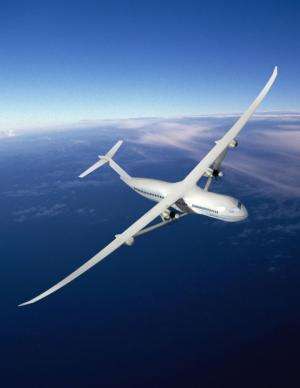(Phys.org)—Boeing has been working on a project that signifies the future of commercial air transportation. As the story goes, about five years ago at a conference on advanced aircraft technologies, posing questions on what the future of aircraft would look like, somebody stood up and said, "What about an electric airplane?" Almost everyone laughed. Boeing personnel did not laugh. Can we make an airplane that has batteries that actually works? They took it as a challenge, in designing a commercial plane capable of low-emission flights. Marty Bradley, technical fellow with Boeing Research & Technology, and part of its SUGAR (Subsonic Ultra Green Aircraft Research) project, has been talking about the company's hybrid electric design, the SUGAR Volt, ever since.
This is designed as a plane that will combine electric power with traditional fuel. Boeing sees it as an energy-efficient model for future commercial flying. The Volt concept is a hybrid propulsion system, using both jet fuel and batteries, a greater wingspan and open-rotor engines. It plugs in at the airport, charges its batteries up, and flies its mission. To enable portions of flight with low or zero emissions, electricity is used as a supplement or replacement. Dual-turbine engines would be powered by traditional jet fuel, and at cruising altitude, the system could turn over to electrical power. Adding energy-plus points, the SUGAR Volt's longer wings allow for greater lift and the wings can fold when landed to accommodate airport gate space.
Boeing noted that the fuel burn reduction and the 'greening' of the electrical power grid can produce large reductions in emissions of life cycle CO2 and nitrous oxide. Hybrid electric propulsion also has the potential to reduce noise.
In the SUGAR study, the team reported that hybrid electric engine technology was a "game-changing technology" and a "clear winner" because it met NASA's goals to reduce fuel burn, greenhouse gases, nitrous oxide emissions, noise and field length. Bradley recently said that Boeing is looking at a 2030 to 2050 time frame for the SUGAR Volt.
Earlier this year, Bradley said that "There is a lot of uncertainty as to how good batteries will be in 2030 to 2050. But we are quite encouraged to see battery companies starting to show real products with much higher performance."
On the larger scale, Boeing's SUGAR team is working to identify future commercial transport concepts for NASA. The team is looking at various concepts and technology options for future years. These include hybrid battery-gas turbine propulsion, fuel cells, fuel cell–gas turbine hybrid propulsion systems, cryogenic fuels, cryogenically cooled engines and associated technologies, advanced batteries and open rotor/turboprop technologies.
The SUGAR Volt, one of the concepts, shows potential to meet NASA's environmental goals, as the SUGAR Volt will emit less carbon dioxide and less nitrogen oxide than aircraft in operation today.
Hybrid is a concept making frequent news in aviation on other fronts. According to reports in November last year, Israel's El Al Airlines planned to outfit 20 of their Boeing 737s with electric drive units that will provide power for the planes to taxi while on the ground. Several other companies were exploring similar ideas.
Bloomberg this year reported that airlines continue studying new technologies and one study area, similarly, is taxiing. Equipment makers such as Honeywell are devising electric motors that can move jets, which would allow pilots to taxi without having to depend on main engines or diesel tractors.
The first new aircraft with electric-taxi technology may be in production in as few as three years, according to Bloomberg Businessweek.
© 2012 Phys.org























